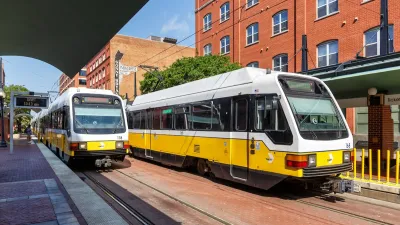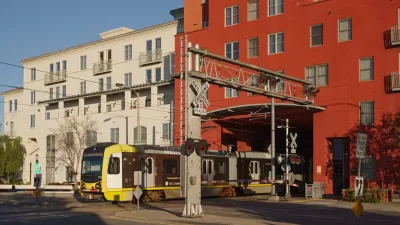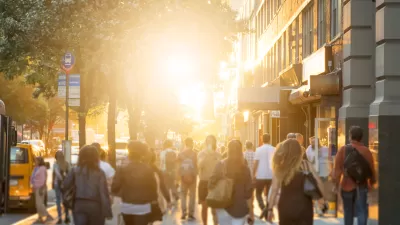The common wisdom about walkable neighborhoods holds that density – proximity to destinations – determines the number of walking trips. An ideal walking distance of a quarter mile is usually prescribed between residences and the nearest transit stop or retail center. I don’t dispute that walking distance is important, especially when I’m lugging an armload of groceries. However, some trendy high-density development favors compactness at the expense of comfort and safety.
The common wisdom about walkable neighborhoods holds that density – proximity to destinations – determines the number of walking trips. An ideal walking distance of a quarter mile is usually prescribed between residences and the nearest transit stop or retail center.
I don't dispute that walking distance is important, especially when I'm lugging an armload of groceries. However, some trendy high-density development favors compactness at the expense of comfort and safety.
An award-winning transportation research paper found that pedestrians typically walked farther than they thought to reach a transit stop: a half mile instead of a quarter mile. It also cited an absence of barriers as a major factor in the decision to walk. In my opinion, such barriers, both physical and perceived, are a stronger deterrent for pedestrians than distance. They include dangerous intersections, isolated or unsafe areas, high traffic density, parking lots, narrow sidewalks and poor lighting. If a route is pleasant and obstacle-free, pedestrians may well underestimate the time and distance of their trips.
Several new housing developments in my city are built literally within a few hundred yards of a shopping mall. But all of these dense, "mixed-use" housing-and-shopping pairs are bisected by major roads, requiring residents to cross multiple lanes of traffic in order to access shopping. (Worse, there are no grocery stores to be found, just warehouse retail. Would you walk to Costco?)
Most people are willing and able to walk more than a quarter mile; people who prefer walking would like to have the space to move. Time and distance are certainly an issue for hurried commuters, for the elderly or disabled, and during extreme weather. Still, a commute on foot can be a good replacement for a daily workout, especially when so many commuters today are sitting in their cars for hours, stuck in traffic. I have comfortably walked a few dozen blocks in New York City, but I would rather drive across the street in the neighborhood pictured above. If good urban planning is supposed to promote an active lifestyle, I wouldn't call walking 100 yards across a smoggy intersection active or healthy.

Alabama: Trump Terminates Settlements for Black Communities Harmed By Raw Sewage
Trump deemed the landmark civil rights agreement “illegal DEI and environmental justice policy.”

Planetizen Federal Action Tracker
A weekly monitor of how Trump’s orders and actions are impacting planners and planning in America.

Why Should We Subsidize Public Transportation?
Many public transit agencies face financial stress due to rising costs, declining fare revenue, and declining subsidies. Transit advocates must provide a strong business case for increasing public transit funding.

Understanding Road Diets
An explainer from Momentum highlights the advantages of reducing vehicle lanes in favor of more bike, transit, and pedestrian infrastructure.

New California Law Regulates Warehouse Pollution
A new law tightens building and emissions regulations for large distribution warehouses to mitigate air pollution and traffic in surrounding communities.

Phoenix Announces Opening Date for Light Rail Extension
The South Central extension will connect South Phoenix to downtown and other major hubs starting on June 7.
Urban Design for Planners 1: Software Tools
This six-course series explores essential urban design concepts using open source software and equips planners with the tools they need to participate fully in the urban design process.
Planning for Universal Design
Learn the tools for implementing Universal Design in planning regulations.
Caltrans
Smith Gee Studio
Institute for Housing and Urban Development Studies (IHS)
City of Grandview
Harvard GSD Executive Education
Toledo-Lucas County Plan Commissions
Salt Lake City
NYU Wagner Graduate School of Public Service






























